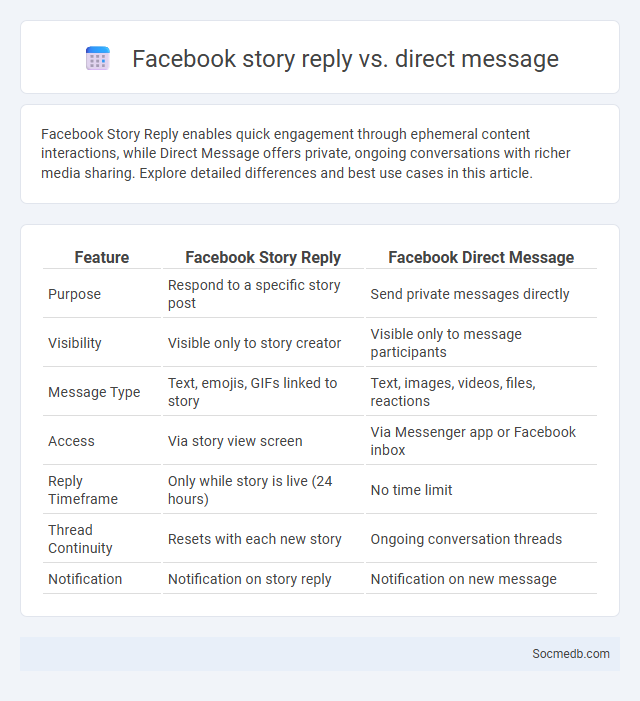
Photo illustration: Facebook Story Reply vs Direct Message
Facebook Story Reply enables quick engagement through ephemeral content interactions, while Direct Message offers private, ongoing conversations with richer media sharing. Explore detailed differences and best use cases in this article.
Table of Comparison
| Feature | Facebook Story Reply | Facebook Direct Message |
|---|---|---|
| Purpose | Respond to a specific story post | Send private messages directly |
| Visibility | Visible only to story creator | Visible only to message participants |
| Message Type | Text, emojis, GIFs linked to story | Text, images, videos, files, reactions |
| Access | Via story view screen | Via Messenger app or Facebook inbox |
| Reply Timeframe | Only while story is live (24 hours) | No time limit |
| Thread Continuity | Resets with each new story | Ongoing conversation threads |
| Notification | Notification on story reply | Notification on new message |
Understanding Facebook Story Reply
Facebook Story Reply allows your audience to engage directly with your content by sending messages in response to your stories, enhancing personal interaction. This feature provides real-time feedback and strengthens connections by enabling quick and private conversations. Understanding how to manage and respond to these replies can boost your social media engagement and foster a loyal community.
Key Features of Direct Messages on Facebook
Direct Messages on Facebook enable private, real-time conversations with individuals or groups, supporting multimedia sharing including photos, videos, and voice recordings. The platform integrates features like read receipts, typing indicators, and message reactions to enhance interaction transparency and engagement. End-to-end encryption in Secret Conversations ensures user privacy and security for confidential communications.
Facebook Story Reply vs Direct Message: Core Differences
Facebook Story Reply allows Your audience to respond publicly or semi-privately to a story, creating interactive engagement visible to friends, whereas Direct Message provides private, one-on-one communication for more personal conversations. Story Replies are designed for quick reactions and comments within a 24-hour window, while Direct Messages support ongoing, secure exchanges with multimedia sharing capabilities. Choosing between these depends on whether Your focus is on social interaction or confidential messaging.
User Engagement: Story Replies vs Direct Messages
User engagement on social media demonstrates distinct interaction patterns between story replies and direct messages, with story replies often generating higher volume due to their ephemeral and interactive nature. Story replies enable quick, casual feedback that fosters real-time connection, while direct messages typically provide more personalized, in-depth communication. Platforms like Instagram and Facebook report up to 70% higher engagement rates on story replies compared to direct messages, highlighting their effectiveness in driving immediate user interaction.
Privacy Considerations: Story vs Direct Messaging
Social media privacy considerations differ significantly between Stories and Direct Messaging. Stories are publicly viewable by your followers and often remain accessible for 24 hours, raising risks of wider audience exposure. Your Direct Messages offer a more secure, private communication channel with specific recipients, allowing you greater control over who sees your content.
Communication Context: When to Use Each Method
Social media platforms offer diverse communication contexts tailored to specific needs: use Twitter for real-time updates and concise messaging, LinkedIn for professional networking and industry insights, and Instagram for visual storytelling and brand engagement. Choosing the right method depends on audience demographics, message purpose, and desired interaction level. Understanding each platform's strengths enhances message effectiveness and fosters meaningful connections.
Business Uses: Story Replies vs Direct Messages
Social media platforms offer businesses powerful tools for customer engagement, with story replies fostering spontaneous, interactive conversations that enhance real-time audience connection. Direct messages provide a more private and structured communication channel, ideal for personalized support, detailed inquiries, and building long-term customer relationships. Your strategy should balance these features to maximize responsiveness and customer satisfaction across varied communication preferences.
Notification and Visibility: Story Replies vs DMs
Story replies on social media generate immediate notifications that enhance user engagement by encouraging quick interactions, while direct messages (DMs) offer more private, in-depth communication with less frequent but more targeted visibility. Stories provide ephemeral, context-driven responses that increase the likelihood of real-time engagement, whereas DMs are prioritized in inboxes for ongoing conversations, ensuring sustained connection and personalization. The distinction between story reply notifications and DM alerts directly impacts how users manage visibility and respond to social interactions on platforms like Instagram and Facebook.
Pros and Cons of Story Replies vs Direct Messages
Story replies on social media offer quick, casual interactions that boost engagement by allowing Your followers to respond instantly to content, fostering a more spontaneous connection. However, the public or semi-public nature of story replies can limit privacy and sometimes lead to overwhelming or irrelevant responses. Direct messages provide a more private, organized conversation space ideal for meaningful, one-on-one exchanges but may require more effort to manage and filter through numerous individual chats.
Choosing the Right Method for Effective Communication
Selecting the appropriate social media platform is crucial for effective communication, as each channel caters to different audience demographics and content styles. Understand your target audience's preferences and behaviors to tailor your messaging, whether it's the visual appeal of Instagram, the professional tone of LinkedIn, or the brevity of Twitter. By aligning your communication method with your audience's expectations, you enhance engagement and ensure your message resonates clearly with Your followers.
 socmedb.com
socmedb.com